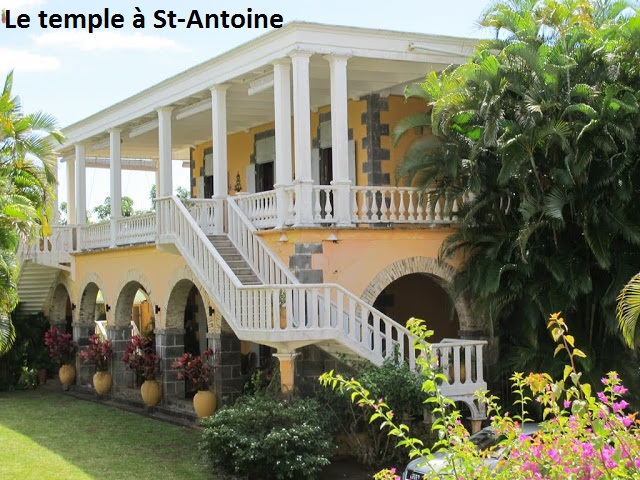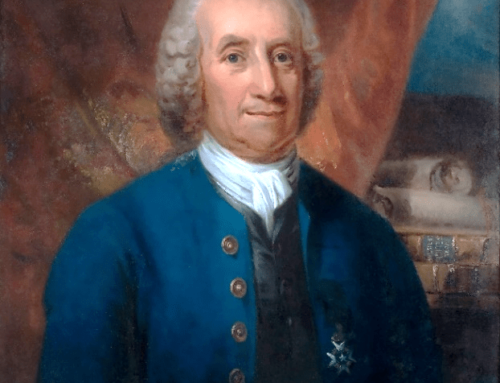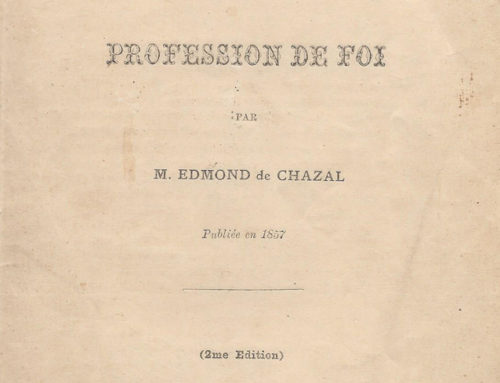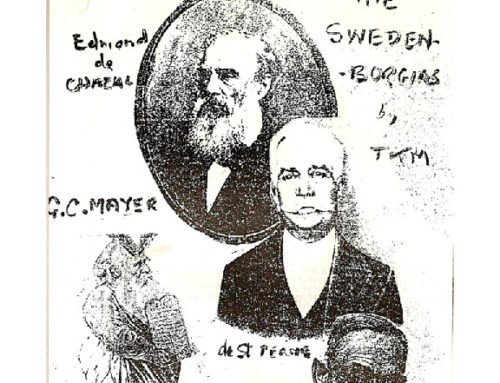Joseph Antoine Edmond de Chazal
A Man of the New Church
By
Pierre de B. Baissac
A presentation given on the occasion of the Chazfest
Durban, South Africa
April 2012
Dear friends
I will talk to you today about a most extraordinary person, one of those truly great men who has handed down an immense intellectual, moral and spiritual wealth and legacy, a person who is seldom if ever in our thoughts, and to whom not one street, road, park has ever been named or monument raised. In fact, we are assembled here today, ultimately because of him and his wife. I am talking of our common ancestor to all the Chazal descendents here present, (he was the father of 15 children) Edmond de Chazal and his wife Claire Rouillard.
When one asks, in Mauritius, who was Edmond de Chazal, the answer, from those who remember his name, is generally: He was the founder of St Antoine SE but he is better known as the founder of the Swedenborgian Church in Mauritius.
I would like to show that he was much more than just that, I would like to show what led him to whole heartedly adopt the doctrines handed down by Swedenborg, show the legacy he has left and pay tribute to this extraordinary, largely forgotten and unrecognised man.
Edmond was born in March 1809, the third child but eldest son of Toussaint Antoine de Chazal and Anne Rivalze de St Antoine. His parents were wealthy and innovative land owners. They owned a large estate in the centre of the island called Le Mondrain.
His father was a man of great hospitality and culture who became a close friend of the first British governor in Mauritius, Sir Robert Farquhar. He and his wife were frequent guests of the Governor at his residence, Le Reduit, where Toussaint in fact died one evening.
His mother was doted of, I quote, “the most charming qualities”, but was also a strong willed person, a mother truly devoted to the welfare of her family and children. This, and the strongly united marriage of his parents, though he hardly knew his father, was no doubt to serve as his guiding light throughout his life.
When Toussaint died in 1822 Edmond was 12 years old. In 1827 his mother sent him to France to pursue his studies and to take up a profession. He studied law for one year but then decided that this was not his vocation and instead worked in France and Britain gaining experience in business. After seven years he returned to Mauritius in 1834, just a few months before his mother’s death. He took on the administration and liquidation of his mother’s estate which was settled in November 1835.
In the mean time, in May 1835, he married Marguerite Claire Rouillard and in November of that year, no doubt on the liquidation of his mother’s estate, he bought a property in Poudre d’Or in the NE of the island with the aim of developing agriculture, very much in the tradition of the family then, tradition which seems to have pretty much disappeared in the family today, except perhaps in South America where they are still going strong. He called the estate St Antoine in honour and memory of his mother’s family name. Over the years he added on to St Antoine, buying large tracts of land around to make it one of the largest sugar estates in Mauritius.
Edmond was a hard worker, a keen observer, always willing to try new ideas and techniques. He greatly improved the sugar milling techniques and was the first to try irrigation of his cane fields in Mauritius.
I would like to quote Nicholas Pike, US Consul in Mauritius, from his world renowned book “Sub-Tropical Rambles in the Land of the Aphanapterix” 1873, an account of his travels around Mauritius in which he describes a visit to St Antoine in the late 1860s:
“This estate is in fine cultivation and the establishment has always been kept up in a style worthy of the true gentleman of the old French school to which M. De Chazal belongs. His reputation for kindness and hospitality has spread far and wide- from the Governors of Mauritius downward- all have shared his large-hearted hospitality. I must add one other mite of praise, like the “Old English Gentleman”:
“Although he feasted all the great,
He ne’er forgot the small.”
I continue with the quote:
“I should mention that our host has a fine family of twelve sons and daughters (from whom all the descendents present here today are issued) several of whom are married, and following in their father’s steps. When all are assembled, children, sons and daughters-in-law, grand children, and servants, my friend looks like a patriarch of old at the head of his household, which resemblance is heightened by a flowing white beard and a bald head; and his amiable wife will even yet bear comparison with his daughters.”
And again: Lord Lindsay visited Mauritius in 1874 to observe the transit of Venus, an event anticipated then as “probably the most important astronomical event of the century”. I quote a paper: “A resident of the island, Eduard de Chazal, offered the party a site on his estate at Belmont, sixteen miles from Port Louis (latitude 20◦ S), and put his house at the disposal of the astronomers for the duration of their operations (Fig. 5)” (3 months).
.
Figure 5 The expedition’s observatory at Belmont (Mauritius Transit of Venus 2004 Committee)
Of course the author meant Edmond de Chazal. Belmont was a portion of the estate not far from St Antoine.
I continue: “Before the Dun Echt astronomers dismantled their station on Mauritius in 1874 their host Monsieur de Chazal made a generous gesture which Lord Lindsay put on record in his Report of the expedition:
I wish now to express my feelings of gratitude towards those who were so kind to me and mine during my three months’ stay on their island. Towards Mons. De Chazal and his family I shall ever bear the warmest feelings of regard and sympathy. He most generously placed at my disposal, during my stay, the house and buildings of his estate at Belmont in the district of Poudre d’Or, in the north-east part of the island, about sixteen miles from Port Louis. When prostrated by fever, had I been his own son I could not have been cared for with more tenderness. Not content with thus ministering to the wants of the present, he executed a gift to the Government of the site upon which my observatory was placed, considering that it would be well, in the interests of science, that the actual spot on which the observations were taken should be preserved, and should not share the fate of the Base measured in 1753-54 by the Abbé La Caille, which unfortunately cannot now be identified(22).
On this ground I claim for Mons. de Chazal the gratitude of future generations of astronomers and geodetecists.(23)
He further declared having found in his host “the ideal he made for himself of a French gentleman and an old colonial”.
On Edmond de Chazal’s death a few years later, Lord Lindsay, then President of the Royal Astronomical Society, paid further tribute to him at a meeting of the Society, as “a gentleman who, though not a Fellow of the Society, had done very much for her science, who had placed his observatory in the hands of Her Majesty’s Government, and whose interest in the work was only equalled by his kindness during Lord Lindsay’s illness.”(24)
Edmond’s wish has been honoured by the Government of Mauritius. The site at Belmont, where Lord Lindsay’s observatory stood, has been cleared and its foundations revealed. It is now designated a National Monument, and a special committee celebrating the 2004 Transit of Venus included in its festivities a commemoration of that historic expedition and the naming of Lord Lindsay Avenue.
Edmond employed 1000 labourers from India. To place this in perspective he bought St Antoine in 1835, the year of the abolition of slavery throughout the British Empire, and of course Mauritius. Forming part of the estate were 330 arpents of land, one house, buildings, plantations, and 150 praedial apprentices. These were freed slaves but still attached to the soil in the form of an indenture for a remaining four years.
Once entirely free these ex-slaves, understandably, no longer wanted to work for their old masters and in the fields. Labour was therefore imported from India, the indentured labour of the day.
As we have seen Edmond was a great humanist, very dedicated to the welfare of people. There is or was an oral tradition in our family in Mauritius concerning the treatment given to slaves by the established church of the time, the Catholic Church, which he felt to be an inhuman. The story is that at the funeral service of a catholic slave the coffin was left outside the church, a well documented fact, while the service went on. This, naturally, was not the case for a white or a freed person. This revolted him and contributed to turning him away from that church, the church of his birth and upbringing, no doubt leading to his spiritual quest and the adoption later of the doctrines given by Swedenborg.
His heart was so much into the moral and material welfare of his employees that he created the first hospital and the first school on a sugar estate in Mauritius for his labourers and staff who were essentially hindoo (Aunauth Beejadhur Les Indiens à l’île Maurice 1935).
The love and esteem by all for Edmond was such that at his funeral service in 1879, I quote Le Cernéen, a newspaper of the day:
“An immense crowd was present today at the funeral of Mr. Edmond de Chazal. His friends were not the only ones present: it seems that deputations had been sent from every part of the colony to pay homage to this great man.
The convoy was followed by one thousand Indians, all his workers of St Antoine and Mon Rocher, to whom were joined those of the neighbouring estates. Not one had been requested to come; all had come freely and of their own initiative.”
It is this man who, after years of meditation and scrutiny of conscience concerning faith and problems of religion adopted fully the faith of the New Church.
In 1846 Mr. Herbert Poole, one of the founders of the New Church in Adelaide, Australia, visited Mauritius where he spent the next four years, introducing people to the writings of Swedenborg. One of these people was a poor painter, Mr. Louis Emile Michel who introduced Edmond and the two brothers Lesage to Swedenborg. In 1854 he sent Edmond a large number of Swedenborg’s works.
These gentlemen began to study carefully and diligently these books, and it was not long before they accepted unreservedly all the truths they contained. Since that date, 1854, a new and vigorous impulse was imparted to the movement. Edmond accepted fully the doctrines of the New Church as soon as he became acquainted with them and began a regular exchange of correspondence with Mr. Le Boys des Guays in France asking him for advice.
Jacques François Etienne Le Boys des Guays came across the writings of Swedenborg in 1834 and also became immediately swept over. In 1837 he started regular home worship. In 1848-9 he started the translation of all the doctrinal works of Swedenborg plus the Index which he completed in 7 years. Today this translation is still the reference in French.
Edmond sent him large sums of money, possibly equal to or even superior to all other subscriptions and donations according to my sources, to be used for the printing and publishing of his translations of Swedenborg’s works.
By his intelligent teaching he soon brought his large family to the light of the New Church, and, in 1858, he started a “Family Worship” group at his home at St Antoine, in which many relations and friends took part. Every member of the family had his complete set of writings.
These are now unavailable except for the old originals. I am fortunate to have two almost complete sets and I understand that there is one set in Argentina that was brought over by …..
Some of the books were modernised in language by Tristan’s parents in the 1970s which are now available.
More people joined the pioneers of the Church and on the 11th January 1859 these formed a Society under the name of “Society of the New Jerusalem of Mauritius”. Those who gathered together on that day at the home of the Lesage brothers, at Champs-de-Mars (Port-Louis) were: Messrs. Edmond de Chazal, Evenor de Chazal, Auguste de Chazal, Pierre Edmond de Chazal, Barthelemée Helie, Charles-Augustus Chasteauneuf, James and Napoleon Le Sage. The other members, to their great sorrow, could not be present.
Once a month, the Society assembled for business in Port-Louis, at the home of the Lesage brothers at Champs-de-Mars; Divine worship took place at Saint Antoine where a small house was set apart for this purpose. This place was called Le Temple.
Edmond was a prolific writer. In 1857 he wrote his Profession of Faith addressed to his family in which he gives his deepest convictions for adopting the New Church.
In 1859 he wrote “Je Suis un Apostat” I am an Apostate or I am a Renegade, a most severe indictment against the Catholic Church of the day which had revoked him simply because he had questioned its authority. Edmond was excommunicated by the Pope. I cannot find a date for this event at this stage.
In 1861, two years after the formation of the Society, the members decided to spread the teachings of the New Church by means of a monthly publication which was to be the echo of the New Church Societies of the World. The first issue of this paper appeared in September 1861 under the title of “Echo of the New Jerusalem”. For the next seven years Edmond was its principal collaborator, writer and funder.
With the spreading of the New Church doctrines through the “Echo”, trouble was started by the Roman Catholic and Protestant clergies. They attacked Edmond de Chazal in letters and pamphlets with all the vigour and might that they could muster.
Amongst other letters I would like to cite one in particular by a Roman Catholic priest, Abbe Spelissy who, whilst professing deep sympathy for Edmond and much respect for his family, told him in a letter “that he nurtured the hope of seeing Mr. de Chazal come back to the faith of his fathers, that his eyes would be opened to see the appalling falsities which he was defending with so much energy and perseverance, and that in the end he would disown these terrible doctrines against God and His Church”. He ended his letter by threatening Edmond with the fate of the heresiarchs (according to his beliefs), cruelly punished even in this world for having broken away from Rome; he would either have his bowels ripped open, like Arius, or he would be strangled by the Devil, like Carlostad. The Anglican Bishop, the Very Revd. Bishop Ryan, said that Mr. de Chazal had exchanged one Pope for another, namely, Swedenborg.
Of course Edmond never buckled and instead defended himself and his beliefs with equal vigour.
Monthly family service continued to take place either in Port Louis or at St Antoine. In the continued absence of an ordained minister Edmond and other members filled this function. I must say that this continues to be the situation with the church today in Mauritius.
In 1865, following an important journey to Europe by Evenor de Chazal, Edmond eldest son, strong links were established between the General Conference of the New Church in Great Britain and the Church in Mauritius links which are still strong today. Dr Lucien de Chazal and his brother Marc, or Marco, created the De Chazal Fund vested with Conference for the funding of French speaking ministers.
In 1877 the legal existence of the Society was recognised by a local Ordinance No.4, ratified by Queen Victoria.
From that moment the Anglican clergy began to recognise the existence of the Society of the New Jerusalem in Mauritius, their ordained ministers occasionally attending service.
It seemed now that Mr. Edmond de Chazal had ended his work in establishing the New Church in its external form in Mauritius. He fell ill towards the end of December 1878 and passed into the spiritual world on the 12th February 1879.
Here I quote Reverend Becherel:
“One can sum up in a few words his work for the Church. As one of the twelve Members who founded the Society, he always took an active part in it since its constitution in 1859, till his last illness. Although he was not the first President, he was called to the Presidency two years after its formation, and occupied this position nearly all through the time when the Society was in its provisional state. When it was legally constituted he was to be its first president and held this position till his death. He was the principal supporter of the Society for many years, and if the New Church exists in Mauritius, it is thanks to him.
In the days of trial towards the end of his life he showed courage, resolution and faith in Providence which, with the Lord’s blessings, helped him to save his family’s estate when this was seriously endangered.”
Edmond has left a strong legacy which was taken up by other members of the family.
In 1877 Auguste de Chazal, son of Edmond, left for Natal with his family, where he stayed for eight years. Through his efforts a New Church Society was created in Durban, in which he took an active part until his return to Mauritius in 1885. The present church is the descendent of this first establishment.
The family has been actively involved in the Church in Lauzanne, Switzerland and elsewhere in the world.
The New Church has had many lay preachers, as we now call them, and at least three ordained ministers that I know of descendents of Edmond, Reverends Maurice de Chazal, Norman Mayer, and Christopher Smith.
Let us hope that this tradition continues strongly and that the Chazalian ‘Droit à la Différence’, the right to be different, or the ‘Moutouk’ persists in the future.
Thank You
Pierre de B. Baissac
Durban April 2012
© Pierre de B. Baissac All Rights Reserved





